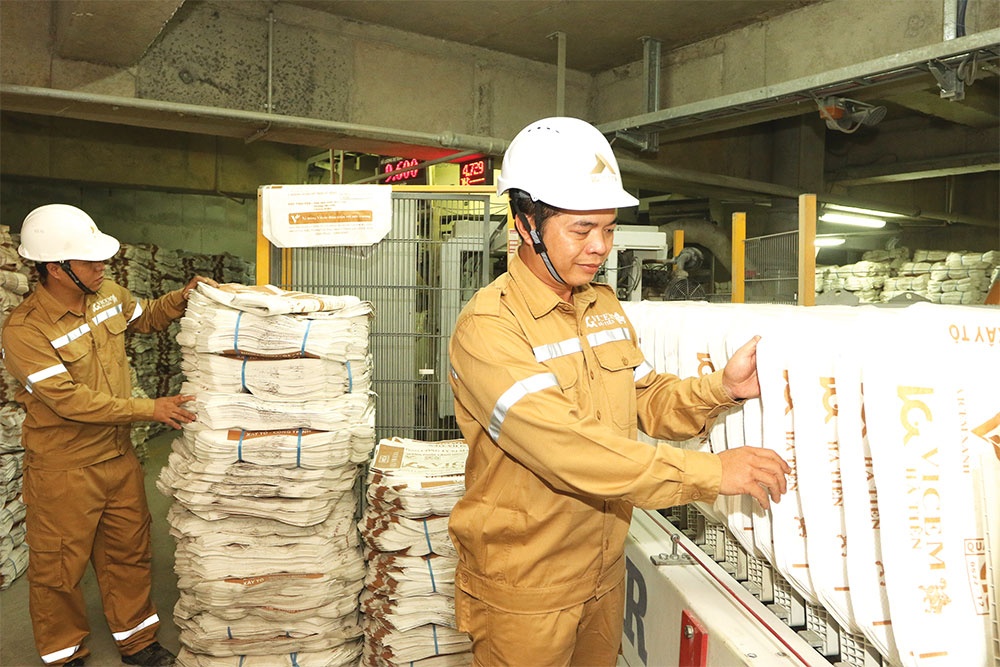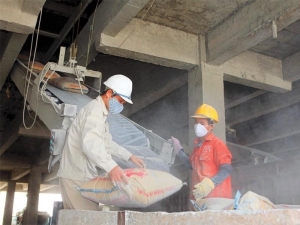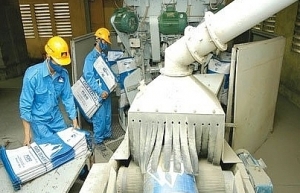Cement producers facing headwinds
According to the Department of Building Materials under the Ministry of Construction, around 7.6 million tonnes of cement were consumed in September, sliding 1.26 million tonnes compared to August and down 15 per cent on-year.
 |
| Vietnam’s north is home to 58 cement production lines, Le Toan |
In which, 5.4 million tonnes were sold in the domestic market, while export reached 2.2 million tonnes.
Generally, in the first nine months of 2022, total cement consumption came to nearly 73 million tonnes, down 10 per cent on-year. In which, more than 47 million tonnes were sold in the domestic market, showing a slight increase of 5 per cent on-year.
Meanwhile, the export volume amounted to 24.7 million tonnes, generating nearly $1.1 billion in the export value, down sharply by 25 per cent in volume and 14 per cent in value on-year.
Pham Duc Trung, deputy director general of Nghi Son Cement JSC, a joint venture in which state-owned Vietnam Cement Corporation (Vicem) has stake, said, “Exports have become an important consumption channel of the cement sector. Nevertheless, exporters have encountered growing obstacles because each importing country is adopting its own import policy and barriers to shield local production. This has been forcing Vietnamese exporters to seek output markets for their products.”
Besides this, the cement sector has seen vibrant mergers and acquisitions (M&A) in the past years, with several regional leading conglomerates in the sector already joining the Vietnamese market through M&A.
For instance, Thailand’s second-largest cement maker Siam City Cement PCL bought Holcim Vietnam Cement, which was later changed into INSEE.; Asia’s leading conglomerate SCG Group brought Buu Long Cement and Song Giang Cement; and Malaysia’s YTL Group owns Fico Cement based in southern province of Tay Ninh.
Local cement brands, after falling into the hands of foreign owners, acquire prevailing advantages in export compared to local ones. After Vietnam’s cement export set a record in 2021 with an export volume approximating 46 million tonnes, cement export has seen a sharp decline in some recent months as China – Vietnam’s major clinker export market – adopted its strict pandemic policy.
The Philippines, Vietnam’s second-largest export market, has been struggling with soaring logistics cost. The country has also imposed over 10 per cent anti-dumping tariffs on made-in-Vietnam cement products.
Cement export, therefore, is expected to continue sliding in the rest of 2022 and even in 2023.
In the domestic market, the expectation of consuming 70 million tonnes of cement a year has yet to come true, and in fact, just 60-65 tonnes of cement were sold annually in the past five years.
Nguyen Quang Cung, chairman of the Vietnam Cement Association, noted, “The cement sector’s designed capacity now reaches 107 million tonnes per year, and can be complemented by more than 20 million tonnes leveraging tech and through revising the additive ratio.”
In recent years, the domestic market just consumed about 60 per cent of the cement sector’s output, and the remaining 40 per cent depended on export. Falling exports in the year to date have badly affected production of businesses in the sector.
Cement inventories, mainly clinker, have amounted to nearly six million tonnes, equivalent to 25-30 days of production, whereas under normal conditions, inventories just equal 15-20 days of production.
Vicem, which holds a third of the domestic market share, has been struggling to push sales. The group’s general director Le Nam Khanh reported that oversupply has made it hard to boost sales.
“In addition, a spike in the production cost due to soaring coal, gypsum, and fuel prices from late 2021 has dampened Vicem’s business efficiency,” Khanh said.
It is reported that the country currently accommodates 81 rotary-kiln cement production lines with a combined annual capacity amounting to 107 million tonnes, placing Vietnam third in the production output behind China and India.
 | Spiking coal price creates mixed sentiment The rising coal price is causing multiple hardships to a host of diverse sectors yet bringing advantages to several others. |
 | Cement makers turn to alternate fuels Through simultaneous energy recovery and material recycling of alternative fuels, the Vietnamese cement sector looks to be on the right track towards achieving sustainable development goals. |
What the stars mean:
★ Poor ★ ★ Promising ★★★ Good ★★★★ Very good ★★★★★ Exceptional
Related Contents
Latest News
More News
- Businesses ramp up production as year-end orders surge (December 30, 2025 | 10:05)
- Vietjet chairwoman awarded Labour Hero title (December 29, 2025 | 13:06)
- How to unlock ESG value through green innovation (December 29, 2025 | 10:03)
- AI reshapes media and advertising industry (December 29, 2025 | 08:33)
- FPT and GELEX sign deal to develop blockchain tech for global markets (December 29, 2025 | 08:29)
- Vietnam’s GDP forecast to grow by 9 per cent in 2026 (December 29, 2025 | 08:29)
- Women entrepreneurs are key to Vietnam’s economic growth (December 29, 2025 | 08:00)
- Vietnam's top 500 value-creating enterprises announced (December 27, 2025 | 08:00)
- The PAN Group shaping a better future with ESG strategy (December 26, 2025 | 09:00)
- Masan Consumer officially lists on HSX, marking the next phase of value creation (December 25, 2025 | 13:20)

 Tag:
Tag:





















 Mobile Version
Mobile Version